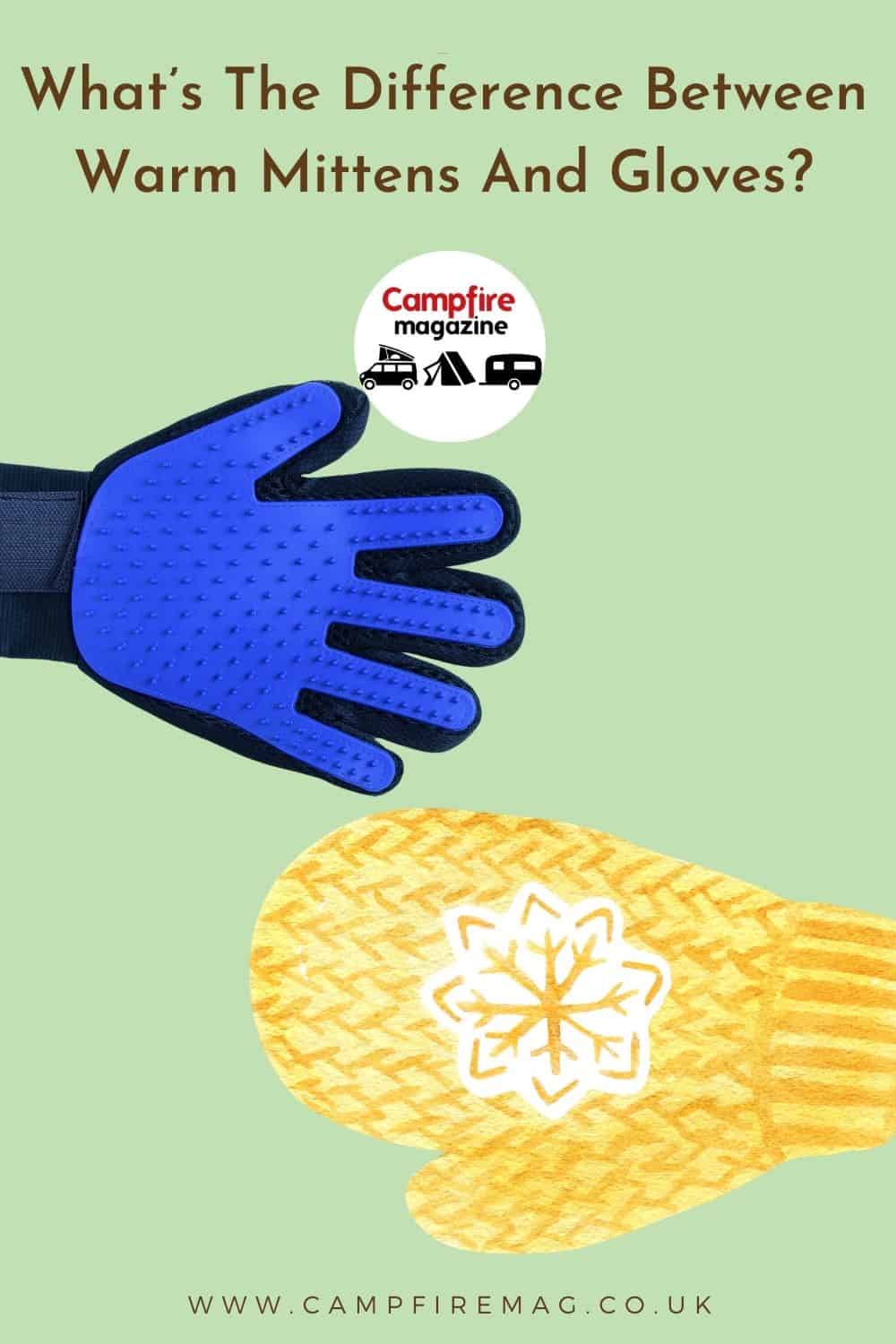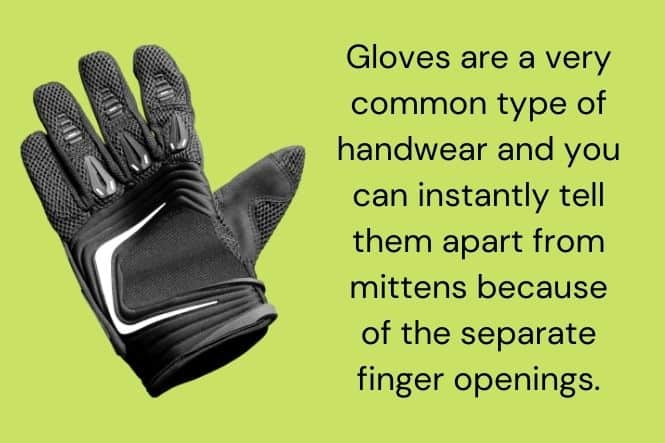Choosing what to wear on your hands is much more important that a lot of people initially think. There are generally two types of handwear; mittens and gloves. While they both do a good job of protecting the hands and keeping them warm, they do have some differences and it’s important to understand these when deciding which is best for you.
If you have struggled to figure out what the difference is between mittens and gloves, you’re in the right place. In this guide, we will be telling you everything you need to know as well as helping you make a more informed decision on which type of handwear to choose for which activities. So, let’s get started.

Getting To Know Gloves
Gloves are a very common type of handwear and you can instantly tell them apart from mittens because of the separate finger openings. There is one for each finger and one for your thumb. In some cases, gloves will have extended wrist and arm covers which are ideal for certain tasks like gardening where you may be prone to getting pricked by thorns and other such things. Moreover, these longer ‘sleeves’ are ideal on gloves that are going to be worn in very cold environments.

The design of gloves, with their separate finger openings means that you do not lose as much dexterity. This makes gloves ideal for many more activities making them the go to choice for skiers, hikers, cyclists and even as a utility glove for things like construction and landscaping.
Gloves are very protective and come in various different materials. The material you choose will depend on what you’re using the gloves for. For example, if you need something to simply keep the hands protected from the cold when you are running errands, a simple pair of polyester gloves might do the trick. On the other hand, if you need heavy duty work gloves, you’ll want to look for more durable materials.
You’ll find gloves made from leather, cotton, wool, nylon, polyester, spandex and many other materials. Some gloves, such as gardening gloves will have a rubber coating for added protection against things like chemicals and pesticides as well as making them more durable. For construction workers and other heavy duty jobs, you may find gloves with reinforced fingers and palms. Not only does this better protect the hands but it also provides the wearer with better grip making them safer to use for certain tasks.
Depending on what you’re doing, you might want waterproof gloves. However, if you do choose these then it is important to opt for a pair that are also made from breathable material as this will prevent moisture from building up on the inside.
A lot of people wear gloves to keep their hands warm on cold days and when you buy gloves for this reason, it’s important to make sure they’re properly insulated. Generally speaking, you’ll want to look for materials such as kevlar, Thermal R, Thinsulate and others. However, if you want a natural material then something like wool is ideal.
Another key thing to think about when choosing a pair of gloves is to make sure that you obtain a good fit. Since gloves are designed to help you retain dexterity, the last thing you want is a pair that slips off and limits how you can use your hands. You also don’t want something so tight that they become uncomfortable as this can limit dexterity as well as affecting circulation. When this happens, you may not feel the benefit of warmth as your hands will naturally become colder as your blood flow decreases.
OUR FAVOURITE GLOVES
We love these lightweight thermal gloves that offer the greatest protection of any pair we’ve seen. They’re versatile enough to be used just as easily on your commute to work as they can be when engaging in more vigorous activities. The thin polyester material is super lightweight but incredibly durable and will stand up to whatever you throw at it. This was the favourite on an article we wrote an about warm thin lightweight gloves.
Getting To Know Mittens
Mittens are a common choice for handwear but unlike gloves they do not have separate finger openings. Instead, there is one opening for all four fingers and an individual one for your thumb. However, just like gloves, mittens come in varying lengths with some only coming to the wrist and others covering part of your arm.

One of the key reasons to wear a pair of mittens is to keep the hands warm. They’re not designed to aid you in retaining dexterity like gloves but many mittens come with some impressive insulation. Yes, this means that they are a lot bulkier but since you won’t be doing any intricate tasks when wearing them, that’s not really a downside. That said, if you wear them for hiking, as an example, you will find that you have to remove them if you need to tie laces, button up clothing or anything similar.
Buying a pair of mittens comes with many of the same considerations as buying a pair of gloves. One of the first things that most people think about is what the mittens are made from and the good news is that you’ll find pretty much all the same materials as you would in the manufacture of gloves so your choices are neither limited or any better.
There are some mittens that are made from lightweight materials such as kevlar and thinsulate and these are excellent for cold weather use. However, you must keep in mind that these are typically a little more expensive than mittens made from things like polyester.
For mittens that may be used in more heavy duty situations, you’ll often find that the weaker parts of the handwear are reinforced, just like gloves. Typically this would be around the thumb and palm which also means the mittens have better grip.
You may also see some mittens that are designed for improved dexterity. These are usually made from some of the lightweight materials we discussed earlier but they may also be made from natural fibres like wool. However, buyers should be aware of the fact that even with these ‘improved dexterity’ mittens, you won’t have the same use of your hands as you would do when wearing gloves.
As with gloves, it’s super important to find a pair of mittens that offer comfort and a good fit. Looking at how tightly or loosely they fit is the best place to start as again, you don’t want to interfere with your dexterity any more than it already is. If the mittens are too tight, you’ll soon begin to feel uncomfortable and then comes the decision of whether to put up with this or remove the mitts and feel cold.
What Are Mittens And Gloves Used For?
Mittens and gloves are somewhat interchangeable, especially when it comes to choosing something to keep your hands warm. However, mittens are normally reserved for cold weather activities, especially when the temperature may dip below zero. This might include things like skiing, snowboarding, ice fishing and other winter sports. That said, some activities such as cycling may require more dexterity than mittens can offer.
That’s where gloves come in very handy (no pun intended!) You can wear these for activities that require the use of your fingers without the risk of them becoming cold. You might use them for backpacking, driving, snowshoeing and other outdoor winter pursuits. That said, be careful when choosing as some gloves are designed for very cold weather and while they will protect the hands from the elements, their bulky design may interfere with your ability to use your hands.
Which Are Better For Cold Weather: Mittens Or Gloves?
No matter what activity you are doing, one of the primary reasons that you would wear gloves or mittens is to keep your hands warm. If you want something that is going to offer ultimate protection against the cold then mittens will always come up trumps. This is because of a combination of the right materials, insulation and thickness.
As well as this, many mittens have little built in pockets that allow you to use a hand warmer. This boosts the heat and makes them the perfect winter handwear. But there’s also something else in their clever design that helps to keep your hands toasty.
When you wear mittens, your fingers are forced close together and this means that they can share heat between them. When you wear gloves, your fingers are separately covered so this process is no longer possible. Yes, the material will keep your hands warm but there’s nothing quite as good as using your own body heat to accelerate the process.
So, What Are The Main Differences Between Mittens And Gloves - Conclusion
The most obvious difference between gloves and mittens is that gloves have separate finger openings while mittens do not; they only have a separate opening for the thumb. The reason for this is to promote better warmth by transferring body heat between the fingers.
Both gloves and mittens are designed with insulating materials and they come in many different forms according to how they will be used. Gloves are a great choice if you will be doing activities that require the use of your hands and you’ll also find them indispensable for work on a cold day. However, mittens are perfect for very cold weather when it doesn’t matter if you lose some hand dexterity.

